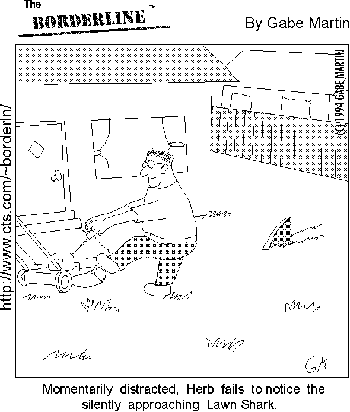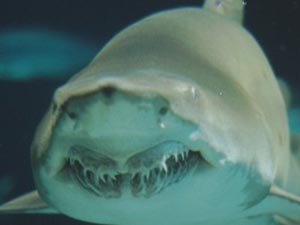|
Every year there are over 100 shark attacks
worldwide. Those who come face to face with the ultimate predator
rarely escape unscathed. Understanding how and why they attack is
our only chance of surviving this natural born killer. But can we
predict their behaviour and avoid their attack?
by Stuart Carter
Near Cape Town, on the Southwest tip of
South Africa, the coastline pounded by the planet's most violent sea.
Here, the Indian Ocean meets the Atlantic, creating the notorious
Cape of Good Hope feared by mariners worldwide. But beneath the waves,
lies a greater danger. There are over 350 different species of shark
that patrol our seas, but three are especially dangerous to man. The
Bull, the Tiger and perhaps the most feared of all the Great White.
Growing to over 20 feet in length and weighing over 3 tones- Great
Whites have few enemies.
33 year old local, Craig Ferreira,
has been fascinated with the behaviour of the Great White for nearly
all of his life.
"If we can really learn enough
about the white shark's interaction with humans, we can provide
positive input or really substantial information to the general
public that use the ocean."
Craig hunts for Great Whites in a stretch
of sea known as 'shark alley', 10 miles off the southerly tip of
Cape Town. Already a veteran of cage diving, Craig now pushes the
envelope even further. He dives with the Great White unprotected
to study how they react to humans in open water. It's a high-risk
experiment. Great White's are intelligent hunters and pick their
prey carefully - they don't get to grow to 20 feet in length by
being reckless…or too timid.
"What you've got to remember when
diving with them is that these animals take out huge seals, they
take out other large sharks, they eat and kill big sharks, so if
that shark decides to do something, you've got absolutely no chance
at all, and obviously as a result you do have close encounters."

A Great White looking particularly menacing.
|
On the other side of the world on the
west coast of Australia, a group of swimmers confrontation with
a Great White revealed how selective a shark can be when choosing
its prey. In Perth there is a local swimming group called the Pod.
One of their members was businessman Ken Crew. The morning of November
6th 2000 started like any other. The 'pod' met on the beach for
their usual 6.30am swim. At the end of the swim over a dozen of
the members stood chest deep water. Then suddenly someone yelled
'Shark! Get out of the water!' The swimmers fled for their lives.
The Great White caught Ken in its massive jaws. The shark had bitten
off his right leg, slicing through a major artery. He'd bled to
death in seconds. But how and why did the shark single out Ken Crew,
in the middle of such a large group of swimmers?
Something about the movement and position of Ken Crew made him more
vulnerable then the other swimmers. The Great White has better colour
vision than any other shark - it's this hunter's greatest asset.
It may have watched him from several hundred yards offshore. It
can stalk its prey with one eye above the water's surface, picking
the moment to close in and strike. As it approaches, a Great White
rolls its eyes back into their sockets. Now attacking blind the
Great White switches to electro detection. The human body is full
of electrolytes and our breathing creates electrical fields that
the shark can home in on. Sensitive capillaries on the snout can
detect currents as low as one 5 billionth of a volt. In the attack
on Ken Crew, the electrical activity from his beating heart may
have been enough for the shark to home in on.

Shark Humour from Gabe Martin
|
But Australia and South Africa are not
the only place with a treacherous coastline. Around the world there
are 14 shark attack hot spots. Danger zones where people are at greatest
risk. As our fascination with using the sea for leisure increases,
so do the number of attacks. 98 of them have happened in the warm
tropical waters of Hawaii.
Three years ago housewife Laurie Boyette
decided to take the long trip from Rhode Island to Kona, Hawaii
for a family vacation. She went swimming in the sea with her nephew;
both were strong swimmers.
"I actually had a premonition
that if there was a shark this is where it would be and at that
point I was a little bit past a raft which was maybe a 150 yards
out. And I thought that was a very strange thought to have but it
didn't scare me I just wondered where it came from."
As Laurie approached the buoys, her
premonition became a reality. She was hit from the backside and
knocked out of the water.
"The actual bite itself was excruciating,
and the only way I can describe it is to say that when you have
a piece of glass in your finger it's, it, you're very uncomfortable.
Well you can imagine having a thousand pieces of glass in your backside."
As she struggled to push the Tiger
shark away, her hands tore against the razor sharp serrated teeth.
"I raised my hands up in front
of my face and I saw pieces of flesh hanging down to my palms."
Although Laurie's hands had only been
in contact with the teeth for a second, the damage was enormous.
Flesh was torn from the bone. Nerves and tendons were shredded.
But nothing could prepare the surgeons for the full extent of her
injuries. They found the entire right buttock missing. The teeth
had bitten a hole 16 inches in diameter. Saving Laurie's life was
a race against time. The shark's teeth had sliced through arteries
and she needed over 20 pints of blood just to keep her alive. Three
years on Laurie has made a full recovery, but like others who've
come face to face with oceans greatest killer - she still bears
the scars.
But why did the shark attack her? Was
it because she was swimming on the surface or that women are at
greater risk then men? It seems highly unlikely that sharks can
distinguish women from men and there is certainly no statistical
evidence to back this up. It is far more likely that she was attacked
because she was thrashing about on the surface. Surfers get attacked
the most. One reason why surfers might get attacked so often is
that they spend more time in the water than any other user group.
They spend more time in than bathers, divers and windsurfers together
- they spend a huge amount of time in the water.
Like many teenagers who live on the
island of Hawaii, Jesse Spencer spends hours in the ocean waiting
for that next big breaker. On the afternoon of October 1st 1999,
he was at his favourite surf beach paddling into deep water. He
was about to learn of a shark's attraction to movement on the surface
and their readiness to have a quick taste. Like most shark attacks,
Jesse's strike came out of the blue.
"I just felt a big bump. As I
was turning my head I was thinking maybe a turtle another surfer.
I don't think a turtle could bump me that hard. So then I turned
and sort of saw the shark pop up and went over my arm and I went
under water. I could feel the tips of the teeth pretty sharply.
They first touched my skin and then went through, and I couldn't
feel anything."
The shark that attacked Jesse was a
Tiger and like most species its teeth are perfectly adapted for
cutting through tough skin and muscle. Jesse was bitten and let
go - the shark clearly didn't want to make a meal of him. So why
was he attacked? Was it a case of mistaken identity? Some scientists
believe that if the animal's motivated to feed then what's the risk
in going up and taking a little taste. Jesse's attack took place
in open deep water. He had no defence against the shark that struck
him silently from below. The bite left Jesse's arm so badly mutilated
it's still on the road to recovery. After 2 years, he still doesn't
have full mobility.

Courtesy of animalwallpapers.com
A Sand Tiger
Shark smiles for the camera
|
With over to 100 attacks and 10 deaths
a year, protecting ourselves from shark attacks is becoming ever
more important. Over the last few years the largest increase in
shark attacks has been along the eastern coast of America. The summer
of 2001 witnessed sharks moving in to shallow waters and striking
swimmers near the shoreline. In just 3 weeks there were 20 attacks
and 2 deaths - often in water no more than 3 feet deep. Everyone
wants to know if it was because there were more people in the water
or because the sharks were becoming more aggressive?
We may never know the answer but scientists
from State Longbeach believe we could reduce the number of attacks
if we knew more about their feeding habits. Their research could
help us judge what times of the day it's most dangerous to get in
to shark-infested waters. The scientists are not convinced by the
popular theory that sharks only feed at the beginning and end of
the day. The sharks' stomach contains acid that varies in concentration
depending on how hungry they are. The weaker the strength, the bigger
their appetite. Using a metal probe, packed with microelectronics,
they plan to look into the digestive habits of a shark. They plan
to feed the probe to a shark and record the times of the day when
stomach acid levels are at their weakest. Then they'll know when
the shark is hungriest and most dangerous. By gutting a squid and
hiding the probe inside, they hope to fool the shark into swallowing
it whole. Then by tracking and down loading data remotely, they'll
be able to pin point exact feeding times on any shark.
There's still much to learn about the
science of shark attacks. Those who have lived through the nightmare
have drawn their own conclusions about when it's safe to swim. Science
and technology may be able to help us - but one fact is certain.
As more and more of us take to water, the number of shark attacks
is going to increase.
|
